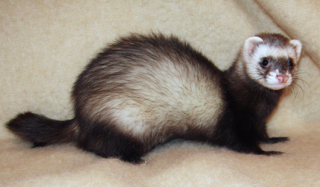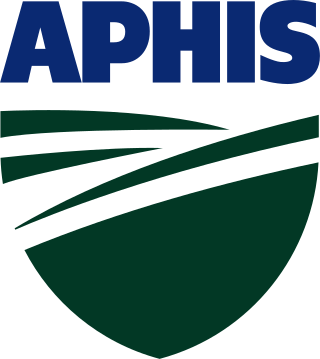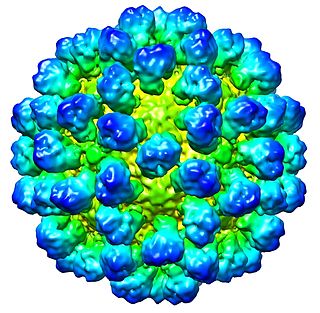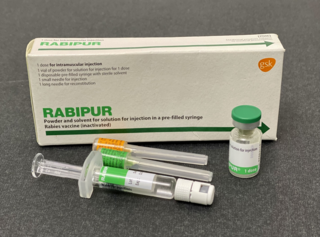
Skunks are mammals in the family Mephitidae. They are known for their ability to spray a liquid with a strong, unpleasant scent from their anal glands. Different species of skunk vary in appearance from black-and-white to brown, cream or ginger colored, but all have warning coloration.

The ferret is a small, domesticated species belonging to the family Mustelidae. The ferret is most likely a domesticated form of the wild European polecat, as evidenced by the ferret's ability to interbreed with European polecats and produce hybrid offspring. Physically, ferrets resemble other mustelids because of their long, slender bodies. Including their tail, the average length of a ferret is about 50 cm (20 in); they weigh between 0.7 and 2.0 kg ; and their fur can be black, brown, white, or a mixture of those colours. The species is sexually dimorphic, with males being considerably larger than females.

An animal shelter or pound is a place where stray, lost, abandoned or surrendered animals – mostly dogs and cats – are housed. The word "pound" has its origins in the animal pounds of agricultural communities, where stray livestock would be penned or impounded until they were claimed by their owners.

The Animal and Plant Health Inspection Service (APHIS) is an agency of the United States Department of Agriculture (USDA) based in Riverdale, Maryland responsible for protecting animal health, animal welfare, and plant health. APHIS is the lead agency for collaboration with other agencies to protect U.S. agriculture from invasive pests and diseases. APHIS's PPQ is the National Plant Protection Organization for the U.S., and the agency's head of veterinary services/veterinary Deputy Administrator is the Chief Veterinary Officer of the United States.

Plum Island Animal Disease Center (PIADC) is a United States federal research facility dedicated to the study of foreign animal diseases of livestock. It is a national laboratory of the Department of Homeland Security (DHS) Directorate for Science and Technology (S&T), and operates as a partnership with the U.S. Department of Agriculture (USDA). The facility's director is Dr. Larry Barrett.
Animal euthanasia is the act of killing an animal humanely, most commonly with injectable drugs. Reasons for euthanasia include incurable conditions or diseases, lack of resources to continue supporting the animal, or laboratory test procedures. Euthanasia methods are designed to cause minimal pain and distress. Euthanasia is distinct from animal slaughter and pest control.
The Pet Travel Scheme ("PETS") is a system which allows animals to travel easily between member countries without undergoing quarantine. A pet passport is a document that officially records information related to a specific animal, as part of that procedure. The effect is to drastically speed up and simplify travel with and transport of animals between member countries, compared to previous procedures if the regulations are followed.

The Animal Welfare Act was signed into law by President Lyndon B. Johnson on August 24, 1966. It is the main federal law in the United States that regulates the treatment of animals in research and exhibition. Other laws, policies, and guidelines may include additional species coverage or specifications for animal care and use, but all refer to the Animal Welfare Act as the minimally acceptable standard for animal treatment and care. The USDA and APHIS oversee the AWA and the House and Senate Agriculture Committees have primary legislative jurisdiction over the Act. Animals covered under this Act include any live or dead cat, dog, hamster, rabbit, nonhuman primate, guinea pig, and any other warm-blooded animal determined by the Secretary of Agriculture for research, pet use or exhibition. Excluded from the Act are birds, rats of the genus Rattus, mice of the genus Mus, farm animals, and all cold-blooded animals.

Canine influenza is influenza occurring in canine animals. Canine influenza is caused by varieties of influenzavirus A, such as equine influenza virus H3N8, which was discovered to cause disease in canines in 2004. Because of the lack of previous exposure to this virus, dogs have no natural immunity to it. Therefore, the disease is rapidly transmitted between individual dogs. Canine influenza may be endemic in some regional dog populations of the United States. It is a disease with a high morbidity but a low incidence of death.

Vaccination of dogs is the practice of animal vaccination applied to dogs. Programs in this field have contributed both to the health of dogs and to the public health. In countries where routine rabies vaccination of dogs is practiced, for example, rabies in humans is reduced to a very rare event.

Rabbit hemorrhagic disease (RHD), also known as viral hemorrhagic disease (VHD), is a highly infectious and lethal form of viral hepatitis that affects European rabbits. Some viral strains also affect hares and cottontail rabbits. Mortality rates generally range from 70 to 100 percent. The disease is caused by strains of rabbit hemorrhagic disease virus (RHDV), a lagovirus in the family Caliciviridae.

The rabies vaccine is a vaccine used to prevent rabies. There are several rabies vaccines available that are both safe and effective. Vaccinations must be administered prior to rabies virus exposure or within the latent period after exposure to prevent the disease. Transmission of rabies virus to humans typically occurs through a bite or scratch from an infectious animal, but exposure can occur through indirect contact with the saliva from an infectious individual.

Rabies is a viral disease that causes encephalitis in humans and other mammals. It was historically referred to as hydrophobia due to the symptom of panic when presented with liquids to drink. Early symptoms can include fever and abnormal sensations at the site of exposure. These symptoms are followed by one or more of the following symptoms: nausea, vomiting, violent movements, uncontrolled excitement, fear of water, an inability to move parts of the body, confusion, and loss of consciousness. Once symptoms appear, the result is virtually always death. The time period between contracting the disease and the start of symptoms is usually one to three months but can vary from less than one week to more than one year. The time depends on the distance the virus must travel along peripheral nerves to reach the central nervous system.
Pet shipping is an industry that involves transporting animals, specifically pets, often by plane. This service is commonly used when the animal's owner is moving house. However, it can also be used when transporting animals for other reasons, such as performing in dog shows. The worldwide industry body for pet shipping is the International Pet and Animal Transportation Association. Pet microchips, vaccinations, rabies titre tests, import permits, and health certificates may be required to ship an animal. Certain breeds are banned from the process due to the increase in associated risk.
The prevalence of rabies, a deadly viral disease affecting mammals, varies significantly across regions worldwide, posing a persistent public health problem.

In animals, rabies is a viral zoonotic neuro-invasive disease which causes inflammation in the brain and is usually fatal. Rabies, caused by the rabies virus, primarily infects mammals. In the laboratory it has been found that birds can be infected, as well as cell cultures from birds, reptiles and insects. The brains of animals with rabies deteriorate. As a result, they tend to behave bizarrely and often aggressively, increasing the chances that they will bite another animal or a person and transmit the disease.
Wildlife Services is the program intended to provide Federal leadership and skill to resolve wildlife interactions that threaten public health and safety, as well as agricultural, property, and natural resources. The program is part of the United States Department of Agriculture’s Animal and Plant Health Inspection Service (APHIS).

Phytosanitary certification verifies phytosanitary worthiness. These certificates are used to attest that consignments meet phytosanitary import requirements and are undertaken by a National Plant Protection Organization (NPPO). Under the Agreement on the Application of Sanitary and Phytosanitary Measures and ISPM, a certificate for export or for re-export can be issued only by a public officer who is technically qualified and duly authorized by an NPPO.
Animals in the Canadian legal system are considered property. Property rights include the rights of possession, the rights of use, and the enjoyment of property to the exclusion of humans. Jurisdiction over animals is divided between the federal government and the provinces under the Constitution of Canada. The federal government, using its criminal law power, has created offences in the Criminal Code, in relation to animal suffering, defining the limitations and penalties in the event of breaches. The federal Parliament also has jurisdiction over the import of animals. The provinces have jurisdiction over animals as part of their power to regulate property laws.
Animal welfare in the United States relates to the treatment of non-human animals in fields such as agriculture, hunting, medical testing and the domestic ownership of animals. It is distinct from animal conservation.














